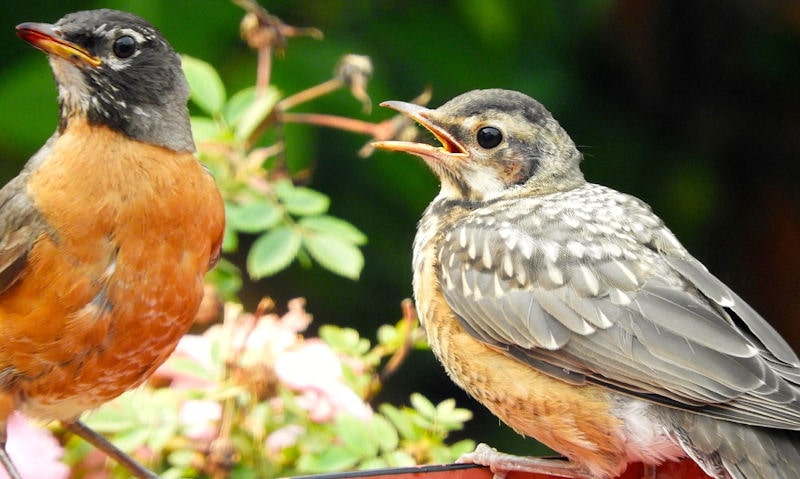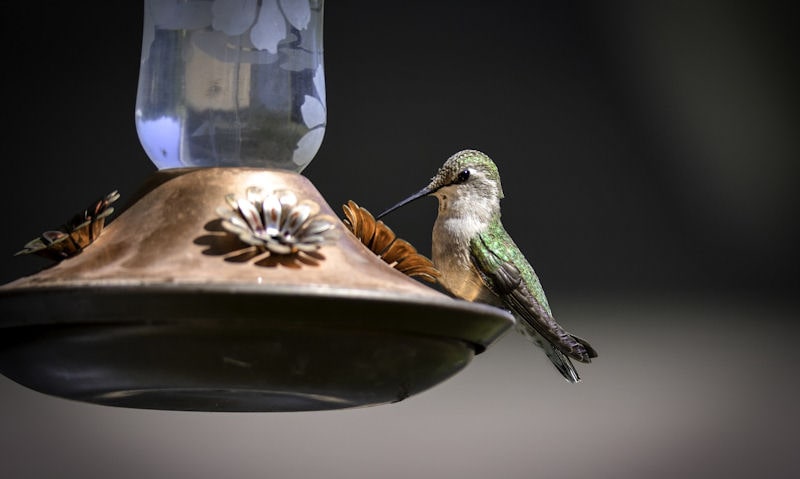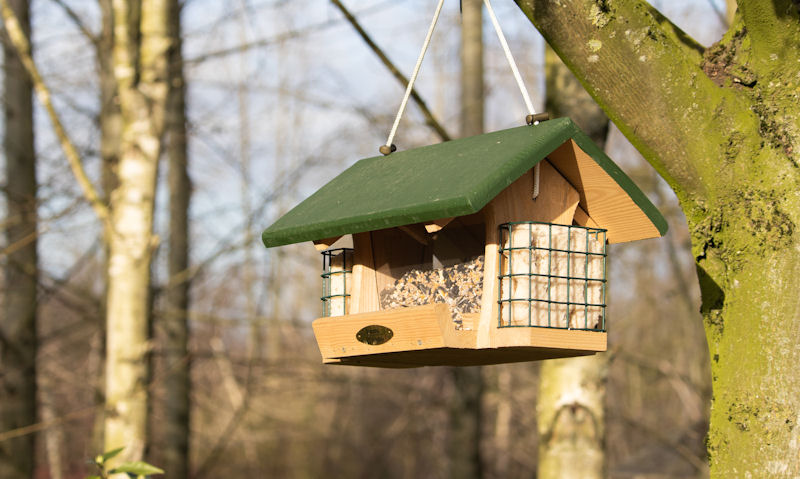Do Robins eat at bird feeders
While a less common backyard bird at bird feeders, its fair to say American Robins do use a bird feeder less often or not at all, as it can depend on their circumstances.
Robins do eat at bird feeders although the bird food offered isn't usually what they eat in the wild, thus are seen to use it less often. To get Robins to eat at bird feeders it must be an open top platform, dish or wire mesh tray mounted to a pole. With that in mind, only offer Robins dried or live mealworms with fruits.
Why you believe Robins don't eat at bird feeders is simply because of their presence in the yard, yet their lack of interest on bird feeders.
In truth, an American Robin mostly eats what is never available in bird feeders, thus this could be why Robins don't eat at bird feeders very often - as they haven't come to depend on the bird feeder food which isn't part of their diet.
Robins can absolutely use a bird feeder once in a while and certainly can be seen to feed on a few surprises, including bird seeds.
With that a Robin can use a bird feeder if its an open platform bird feeder, with use of a bowl or tray mounted to a pole as a good substitute.
On top of this platform bird feeder or in the dish you'd want to add dried or live mealworms to replace earthworms which they love - with apple slices or dried fruits for birds replacing wild berries.
What I am getting at is the bird food that usually goes in a bird feeder would be best served laid out in the open.
Robins are ground feeding birds so dried mealworms over the lawn would be a start.
Robins DO use feeders
American Robins can in fact use a bird feeder although you may of realized by now its not a common sight in your yard.
Robins are not what you would call a common backyard bird feeder bird; a Robins ability to use such a device is restricted to say the least, while a Robins natural behavior usually forces them to forage on the ground as normal.
With that in mind the best way to feed Robins in your yard is on the lawn, as its where they usually reside while foraging in the wild.
Robins are not so recluse they won't at least give more accessible bird feeders a try, with American Robins even seen to like bird baths if made available.
Less agile birds such as Robins will prefer to avoid the type of bird feeders that are self-enclosed, limited to hanging with no real place to perch.
To attract Robins to your bird feeder you'd need to open it up to the elements, then a Robins limited ability can simply land to perch.
Feeders are used less
Bird feeders which are made to hold bird seeds, which American Robins don't usually feed on, are one of the most restricted bird feeders to use.
Robins do eat bird seed at feeders once in a while although the seeds must be scattered on an open top platform, or why not place them in a dish.
Birds such as Robins come to depend on nature to provide for them, with a bird feeder used as a last resort. Result of that is a Robin can successfully perch on a small bird feeder - to at least be sure they get their daily intake of protein.
With that in mind an American Robin will avoid bird feeders if food in the wild is plentiful, without seasonal effects changing their foraging behavior.
Why a Robin doesn't eat at a bird feeder is because of food in the wild is always there, and Robins know this so will continue to feed where nature intended.
Whereas a bird feeder can be seen as bit of an annoyance to Robins even though they can use it in times of need. Robins haven't come to depend on such odd feeders, so will only use it if food runs dry in the wild.
Mealworms or suet feeders
With all that, and an abundance of American Robins in your yard you may just be able to feed Robins what they require.
To know what to give Robins you must first understand what Robins eat in the wild, and its not as much as a variety as you'd think.
Simply put, a Robin will eat insects or berries, including earthworms who the Robin looks out for most on your lawn.
With this kind of food, of course it can't be added to a bird feeder, although bird food similar to this can be popped on top of an open platform bird feeder - or in a dog food dish if no open platform feeder is available.
To replace insects in the wild you can feed Robins dried or live mealworms. They can go on the open top bird feeder yet can be beneficial to Robins if thrown over the ground.
Berries are not bird feeder food, thus the only option is to pop fruit in a dish or on a platform.
When there's snow on the ground you can add dried mealworms on top of the snow while repeating the process everyday as more bird food gets buried.
Layout feeder food
Rather than force Robins to a restricted bird feeder why don't you layout the bird food out in the open, this way bird food is guaranteed to be eaten up.
Common backyard birds of all species will eat the food left out for Robins, which isn't a bad thing as you just need to keep replenishing the dish or platform bird feeder.
To take out a share of the dried mealworms in what could be a clear plastic tube or wire bird feeder, to then put them on the ground or on a higher surface can at least be sure Robins get their fair share.
Personally I like to put bird food on a porch railing, or if I must on the garden furniture.
Anywhere really where I can feed wild birds yet I can observe them as they feed, knowing what kind of birds I am actually attracting to my yard.
Robins will be among them for sure, and will only eat on porch railings, furniture or on the ground - with bird feeders used as a last resort.
What to feed American Robins in your yard is dried mealworms or the live kind if you can stomach it. While a number of fruits can be offered to Robins including apple slices or bananas - and made available out of bird feeders of course.
Rely on platform feeder
Robins can be seen to use compact, yet incompatible bird feeders although its used only because the Robins are hungry or struggling to eat in the wild.
What kind of bird feeders do Robins like most are open trays mounted to a pole or small pet food dishes positioned around the yard.
Robins will use these things as a bird feeder because they are compatible with a Robins less able ability when it comes to feeding off a hanging bird feeder.
With that in mind, what is the best bird feeder for Robins you can possible own, is a pole mounted, open top platform bird feeder.
Why pole mounted is because the platform remains steady as Robins come in to perch, so will feel safe to continue to feed on mealworms, fresh or dried fruits.
Pole mounted platform feeder counterpart in the hanging bird feeder type can be used but is still a little restricting. It can swing in the wind which makes it hard for Robins to land, while the chains used to hang can cause an obstruction.
In addition to a pole mounted platform feeder so to is a ground platform bird feeder, as it will be on the ground close to where American Robins normally forage in your yard.
To summarize
Robins do use bird feeders but as you will already know it can be a rare sighting. Robins eat at bird feeders when wild bird food is scarce, or they are hungry at the time.
Feeders are used less because a Robins ability is restricting at many kinds of bird feeders in use, partially those that are made to hang with bird food trapped inside them.
Robins will be happy to substitute their insects or berries in the wild with dried or live mealworms offered up in the yard by you - with fresh fruit or dried fruit which can make up 60% of they diet annually.
None of this can be added to a self-enclosed bird feeder nor are they found to be added; could it be then American Robins have come to realize what they eat isn't readily available in common hanging bird feeders.
With that in mind Robins can still eat out of a bird feeder if its the open to the elements kind.
It can be a dish located around the yard or a wire mesh tray mounted to a bird feeder pole. If Robins are in need of a daily intake of bird food then they will use these kinds of bird feeders, or else they go hungry.
What is the best bird feeder of all is a pole mounted platform bird feeder with dried or live mealworms, and fruits laid out on top of it.


